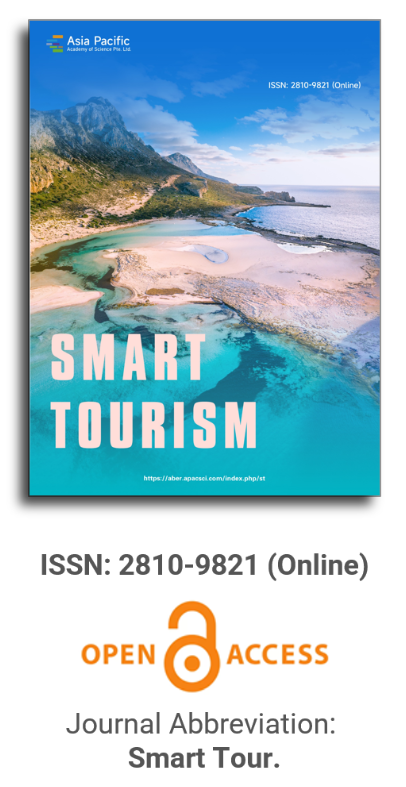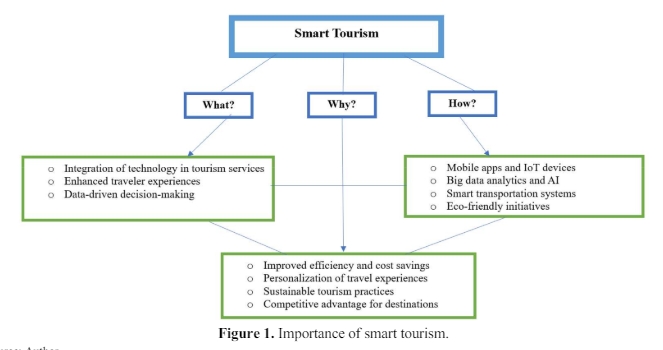


A case study on tourism spatial pattern and its influencing factors from the perspective of real and virtual tourism economic at county scale in Yellow River Economic Belt
Vol 1, Issue 1, 2020
Download PDF
Abstract
Based on the index of tourism Baidu search volume and total tourism income of 667 research units at county scale in Yellow River Economic Belt, this paper uses spatial classification, exploratory analysis of spatial data, nuclear density estimation and other methods to compare and analyze the spatial pattern of county tourism economy in the Yellow River Economic Belt, and then uses the geographical detector model to analyze the influencing factors. The results are drawn as follows. Firstly, from the perspective of spatial distribution pattern, the imbalance of the overall tourism economy is obvious, and the spatial pattern shows a “one big, three small” four core agglomeration pattern. Secondly, from the perspective of spatial correlation pattern, significant HH and LL areas are dominant whether virtual economy or a real economy, and spatial agglomeration effect is obvious. Real economic significant HH areas mainly distribute in the tourism economic developed areas of Shaanxi and Shandong, while real economic significant LL areas are mainly concentrated in the middle and east of Inner Mongolia, the south of Shanxi, most of Qinghai and the north of Ningxia, and scattered in Henan, Gansu and other places. Compared with the entity level, the HH areas of the virtual economy are significantly expanded, mainly distributing in Shandong, Shaanxi and the eastern part of Inner Mongolia. The number of significant LL areas is significantly increased and the distribution range has changed, and the distribution scope of low-value cluster areas mainly distributes in most areas of Qinghai, south and north of Shanxi, and sporadically distributes in Gansu. From the perspective of nuclear density, the spatial structure of virtual and real economy is similar, and the high-value counties mainly distribute in Shandong, Henan and Shanxi forming a high-value gathering area expanding into a core development area. It is worth noting that the virtual economy scope in the north of Shaanxi and the northeast of Inner Mongolia has formed many sub-cores, which indicates that the level of virtual economy in the region is rapidly rising. Finally, according to the results of the Geo-detector model and the coupling matching analysis model, we found the real economy is mainly affected by the resources support level. We also found virtual economy is mainly affected by the level of information technology.
Keywords
References
- Wen J, Ling C. Study on total factor productivity evaluation of tourism in the Yangtze River Economic Zone. Journal of Guizhou University of Commerce 2017; 30(4): 56–61.
- Wand Z, Zhao S. Temporal and spatial dynamic evolution and influencing factors of tourism efficiency in Hunan Province based on DEA-Malmquist model. Resources and Environment in the Yangtze Basin 2019; 28(8): 1886–1897.
- Ma B, Chen X, Lu X, et al. On the coordinated development of international tourism destinations in the five northwest provinces: A perspective of tempo-spatial differences of inbound tourism in the background of the Silk Road Economic Belt. Journal of Xinjiang University (Philosophy, Humanities & Social Science) 2019; 47(5): 1–8.
- Gao L, Zhang D. An evaluation on the comprehensive competitiveness of the tourism industry in Jin-Shan-Yu Yellow River Golden Triangle District. Journal of Shanxi Normal University (Natural Science Edition) 2019; 33(2): 63–67.
- Li G, Tian Y. Validify analysis of tourism resources competitiveness and tourism development level in Pearl River Delta. Economic Geography 2019; 39(3): 218–224.
- Zhou L, Jiang J. Comprehensive evaluation of urban tourism competitiveness in the Yangtze River Delta and its spatial patterns analysis. Economic Geography 2015; 35(1): 173–179.
- Zhang X, Cheng S, Li Z. Analysis on the spatial-temporal disparities of inbound tourism economy in Yangtze River Economic Belt. Journal of Central China Normal University (Natural Science) 2016; 50(5): 783–790.
- Fang F. Analysis on spatial-temporal change pattern and cause of tourism economy difference in Yangtze River Economic Zone. Journal of Nanjing University (Natural Science Edition) 2016; 39(1): 124–131.
- Sun P, Dai X. Analysis on the spatial data of China’s regional tourism economic disparity. Tourism Science 2014; 28(2): 35–48.
- Shen J, Lu Y, Zhou Y, et al. Domestic tourism economic growth and spatial pattern evolution domestic tourism economic growth and spatial pattern evolution of regional tourism differences in Anhui Province. Scientia Geographica Sinica 2012; 32(10): 1220–1228.
- Hua Z, Zhang C, Chen L, et al. Comprehensive evaluation of attraction of tourism resources based on principal component analysis. Journal of Hubei University for Nationalities (Natural Science Edition) 2015; 33(4): 399–401.
- Xu S, Yang J, Liu Y. Characteristics and spatial distribution pattern of tourism resources in western ethnic counties: Taking Jiangkou County as research area. Economic Geography 2019; 39(8): 224–230.
- Zhang X, Cheng S, Sun Y. Spatial distribution and influencing factors of high-level tourism resources in the Yangtze River Economic Belt. Regional Research and Development 2018; 37(5): 95–99.
- Yang Y, Ding Z, Ge J, et al. Coupling coordination between rural tourism informatization and regional tourism economy in Jiangsu Province. Economic Geography 2018; 38(11): 220–225.
- Toader CS. Tourism information centers-proof of tourism management. Agricultural Management 2015; 17(2): 7–10.
- Eraqi MI, Aba-Alla G. Information systems and tourism marketing: New challengers for tourism business sector in Egypt. Information Technology in Hospitality 2008; 5(1): 35–47.
- Zhou C, Feng X, Tang R. Analysis and forecast of coupling coordination development among the regional economy-ecological environment-tourism industry: A case study of provinces along the Yangtze Economic Zone. Economic Geography 2016; 36(3): 186–193.
- Wang H, Lin J, Jiang B. Analysis on the coordination development degree of tourism and environment in Dalian. Marine Environmental Science 2006; 25(1): 84–87.
- Wang W. Study on evaluation and its influencing factors of tourism-economic-ecological environment coordinated development in the Yangtze River Economic Zone. Journal of Capital Normal University (Natural Science Edition) 2018; 39(5): 81–88.
- Wu Y, Song Y. Spatial pattern evolution and influence factors of tourism economy in China. Scientia Geographica Sinica 2018; 38(9): 1491–1498.
- Wang D, Chen T. Spatial analysis for regional difference of tourism economy in China. Scientia Geographica Sinica 2011; 31(5): 528–536.
- Wei W, Deng N. Grey correlation analysis of tourism economy in the Yangtze River Economic Belt. Journal of South China University of Technology (Social Science Edition) 2006; (2): 26–29.
- Fang Y, Huang Z, Li J, et al. Space-time transition of tourism economic growth and its convergence in Chinese mainland. Scientia Geographica Sinica 2018; 38(10): 1616–1623.
- Lu W, Yu J, Cheng S, et al. Research on spatio-temporal characteristics and influencing factors for tourism economy difference in Hubei section of Yangtze River Economic Belt. Journal of Central China Normal University (Natural Science Edition) 2018; 52(5): 730–741.
- Chen Q, Xia L, Wang K. Study on the difference of tourism economic development in the Yangtze River Economic Belt. World Regional Studies 2019; 28(2): 191–200.
- Pan J, Zhang H. The application of principal component analysis method in the evaluation of the impact factors of domestic tourism income. Journal of Shanxi Datong University (Natural Science) 2018; 34(4): 31–33.
- Dong J, Ren L. Research on demand motivation of middle school students study tourism based on the principal component analysis: A case study of Taiyuan. Economic Problem 2016; (7): 119–124.
- Zhang J, Dou P, Jiao S. Study on regional difference of inbound tourism efficiency in Henan Province based on DEA-ESDA. World Regional Studies 2019; 28(1): 111–120.
- Hao J, Lin S, Wang L. Spatio-temporal pattern change of inbound tourism economic in Yangtze River Economic Belt: Based on ESDA & GWR. Resources and Environment in the Yangtze Basin 2017; 26(10): 1498–1507.
- Xi J, Ge Q. The enlightenment of the Yangtze River International golden tourism belt to the innovative development of regional tourism. Progress in Geography 2015; 34(11): 1449–1457.
- Jin H. Analysis of spatial differences of tourism economy in the Yangtze River Economic Belt: Based on the advantages of tourism resources. Modern Industrial Trade 2017; (2): 8–9.
- Ma H, Lun Y, Xi J, et al. Spatial pattern of China’s tourism economic system mismatch degree and its formation mechanism. Scientia Geographica Sinica 2018; 38(8): 1328–1336.
- Zhou N, Xiong A. A panel data study on the spatial dissimilarity of tourism economic effect and improvement measures: Taking Shandong Province as a case. Scientia Geographica Sinica 2016; 36(2): 289–295.
- Fu Q, Liu D, Hu J, et al. Network structure and optimization research on the Hubei Province tourist flow. Economic Geography 2015; 35(3): 191–196.
- Zhu H, Wu Q. Study on tourism size provinces and primary cities in China. Acta Geographica Sinica 2005; 60(6): 41–49.
- He X, Li C, Xu J. Temporal and spatial characteristics and motivation analysis of urban tourism economic differences in Jiangxi Province. Jiangxi Science 2017; 35(4): 634–640.
- Zeng H, Yu R, Zuo Y, et al. Evolution of spatial-temporal pattern and its influential factors of city regional economy in Yangtze River Economic Belt. Economic Geography 2015; 35(5): 25–31.
- Feng X, Zhong Y, Chen L, et al. Evolution of spatial pattern of county regional economy in Yangtze River Economic Belt. Economic Geography 2016; 36(6): 18–25.
- Zhang G. Construction of the Yellow River Economic Belt: Significance, feasibility and path selection. Economic Problem 2019; (7): 123–129.
- An X, Zhang F. Strategic thinking of sustainable development in the Yellow River Economic Zone. Progress in Geography 2000; 19(1): 50–56.
- Ding Z, Liu X, Cheng D, et al. Spatial pattern of urban-rural income gap and its influencing factors at county level in Yellow River Economic Belt. Journal of Henan University (Natural Science) 2019; 49(1): 1–12.
- Wang H, Miao C, Qiao X. Central cities external service capabilities spatial distribution of Yellow River Economic Belt. Economic Geography 2017; 37(7): 33–39.
- Gou T, Lu W. Study on development quality evaluation and spatial differentiation of the Yellow River Eco-Economic Belt. Journal of Qinghai Normal University (Philosophy and Social Sciences) 2019; 41(4): 7–15.
- Liu C, Li E, Qin C. Research on the spatial pattern and evolution of urban and rural coordinated development in China. Human Geography 2012; 27(2): 97–102.
- Xu J. Metrology geography. Beijing: Higher Education Press; 2008.
- Wang J, Xu C. Geodetector: Principle and prospective. Acta Geographica Sinica 2017; 72(1): 116–134.
- Wang K, Huang Z, Cao F, et al. Spatial pattern evolution of urban tourism performance and its influence factors in Pan-Yangtze River Delta. Journal of Natural Resources 2016; 31(7): 1149–1163.
Supporting Agencies
Copyright (c) 2020 Yiwei Meng, Zihan Jian, Gaisu Zhang
License URL: https://creativecommons.org/licenses/by/4.0

This site is licensed under a Creative Commons Attribution 4.0 International License (CC BY 4.0).

Prof. Hung-Che Wu
Nanfang College, Guangzhou
China
Indexing & Archiving
Asia Pacific Academy of Science Pte. Ltd. (APACSCI) specializes in international journal publishing. APACSCI adopts the open access publishing model and provides an important communication bridge for academic groups whose interest fields include engineering, technology, medicine, computer, mathematics, agriculture and forestry, and environment.



.jpg)
.jpg)

.jpg)

